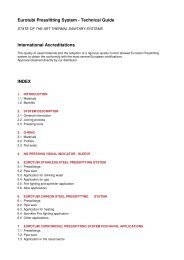corrosion of stainless steel - Damstahl
corrosion of stainless steel - Damstahl
corrosion of stainless steel - Damstahl
You also want an ePaper? Increase the reach of your titles
YUMPU automatically turns print PDFs into web optimized ePapers that Google loves.
Chapter 6 - Corrosion <strong>of</strong> Stainless Steel<br />
1 mm<br />
Figure 6.13:<br />
Pitting <strong>corrosion</strong> photographed with a scanning electron microscope<br />
(SEM). The specimen originates from the same trial series as the one in<br />
Figure 6.9, i.e. 4301 exposed to a critical mixture <strong>of</strong> salt and hydrogen<br />
peroxide. Note the local nature <strong>of</strong> the pitting. Photo: Metallographer<br />
Laila Leth, MEK/DTU.<br />
Oxidising<br />
disinfectants<br />
Cathodic<br />
protection <strong>of</strong><br />
<strong>stainless</strong> <strong>steel</strong><br />
Hydrogen peroxide is a powerful oxidant and an excellent electron eater<br />
which can be seen from its position in the electrochemical series Table 5.1<br />
on page 55. In practice, hydrogen peroxide can force the <strong>corrosion</strong> potential<br />
<strong>of</strong> the <strong>steel</strong> above +500 mV SCE<br />
(+746 mV SHE<br />
), which is the direct cause why<br />
the <strong>corrosion</strong> experiment in Figure 6.9 produced penetration in such a short<br />
period <strong>of</strong> time.<br />
Many cleaning agents contain strong oxidants such as peracetic acid,<br />
persulphate, chlorine, hypochlorite or the above hydrogen peroxide, which<br />
all help to speed up the <strong>corrosion</strong> potential considerably. The combination<br />
<strong>of</strong> saline media and the remainder from strong oxidising cleaning agents<br />
is pure poison for <strong>stainless</strong> <strong>steel</strong> and a frequent cause <strong>of</strong> serious <strong>corrosion</strong><br />
damage at dairies, abattoirs and other locations where frequent and efficient<br />
cleaning takes place. The solution is to ensure that the cleaning time is kept<br />
short (typically 15-60 minutes) so that long-term effects are avoided and so<br />
that the <strong>corrosion</strong> does not initiate at all.<br />
The opposite, positive effect is seen when coupling immersed, <strong>stainless</strong> <strong>steel</strong><br />
constructions with mild <strong>steel</strong> or galvanised <strong>steel</strong>. Just as in Figure 5.8 on<br />
page 64 and Figure 5.9 on page 65 the most precious metal (<strong>stainless</strong> <strong>steel</strong>) will<br />
be protected while the least precious metal (mild/galvanised <strong>steel</strong>) will be<br />
exposed to additional <strong>corrosion</strong>. As the area <strong>of</strong> e.g. reinforcement bars is<br />
very large compared to the area <strong>of</strong> <strong>stainless</strong> <strong>steel</strong>, the additional contribution<br />
from the galvanic coupling will be relatively small. Thereby, the <strong>stainless</strong><br />
<strong>steel</strong> will be cathodically protected without consequence to the mild <strong>steel</strong><br />
reinforcement bars. Because <strong>of</strong> its wide and efficient passive zone (see Figure<br />
5.10 on page 69) <strong>stainless</strong> <strong>steel</strong> is actually well suited to cathodic protection<br />
89<br />
RS for alle.indb 89<br />
9/29/2011 12:44:36 PM

















